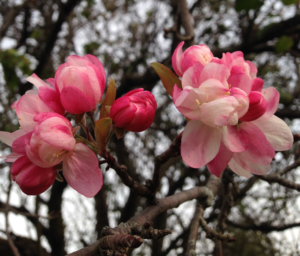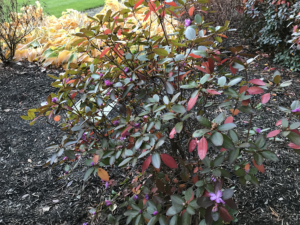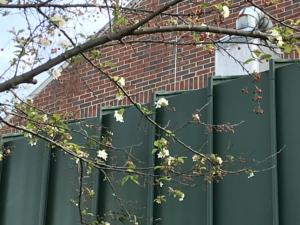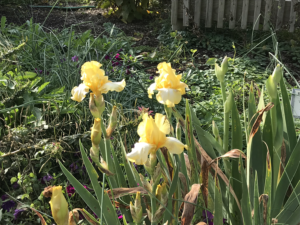What is that crabapple doing reblooming in October and November? Actually, it might be more correct to think of it as jumping the gun on next spring rather than reblooming.

A pink flowering crabapple blooming in fall
Photo credit: Melissa Widhalm, Purdue Climate Change Resource Center

This rhododendron shows both blooms and fall foliage in November
Photo credit: Rosie Lerner, Purdue Extension
Although it happens to some extent many years, there seem to be more reports thas usual of landscape plants blooming out of sequence this fall. Rhododendrons, crabapples, and saucer magnolias are the most commonly reported species blooming this fall.
Spring-blooming woody plants initiate flower buds on previous year’s wood and rely on chilling to stimulate the buds to mature. In other words, the flower buds require a certain amount of chilling before they break out of dormancy to open their flowers. Cool nights – like we’ve enjoyed recently – can provide enough chilling to cause plants to bloom out of their “normal” sequence. And in some cases, stressful conditions (such as summer drought) can substitute for some of the required chilling.

A white flowering crabapple blooming in fall. Cool temperatures at night (or other times) can cause some spring-blooming plants to bloom again in fall.
Photo credit: Rosie Lerner, Purdue Extension
Different species and even cultivars within a species vary in their requirement for chilling units. In general, the earlier the plant flowers in spring, the fewer chilling units it requires to bloom. Plants such as magnolia and some rhododendron commonly rebloom sporadically in summer and into the fall. There are some cultivars of rhododendron and other species that have been cultivated specifically for their ability to rebloom like this. Similarly, some herbaceous perennials (such as iris and daylily) may also rebloom outside their expected sequence.
Another factor for some plants is that the flower buds they initiate in late summer do not develop the proper plant growth inhibitor hormones that normally keep the buds dormant. In such cases, autumn warm spells can induce these flower buds to open.
Although blooming out of sequence may reduce the total amount of bloom for the following spring, it is not harmful. Usually, there are still plenty of buds left to provide a spring show.
